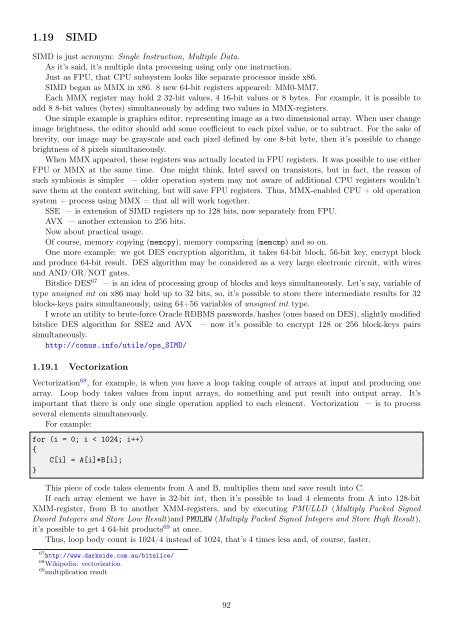Quick introduction to reverse engineering for beginners
Quick introduction to reverse engineering for beginners
Quick introduction to reverse engineering for beginners
Create successful ePaper yourself
Turn your PDF publications into a flip-book with our unique Google optimized e-Paper software.
1.19 SIMD<br />
SIMD is just acronym: Single Instruction, Multiple Data.<br />
As it’s said, it’s multiple data processing using only one instruction.<br />
Just as FPU, that CPU subsystem looks like separate processor inside x86.<br />
SIMD began as MMX in x86. 8 new 64-bit registers appeared: MM0-MM7.<br />
Each MMX register may hold 2 32-bit values, 4 16-bit values or 8 bytes. For example, it is possible <strong>to</strong><br />
add 8 8-bit values (bytes) simultaneously by adding two values in MMX-registers.<br />
One simple example is graphics edi<strong>to</strong>r, representing image as a two dimensional array. When user change<br />
image brightness, the edi<strong>to</strong>r should add some coefficient <strong>to</strong> each pixel value, or <strong>to</strong> subtract. For the sake of<br />
brevity, our image may be grayscale and each pixel defined by one 8-bit byte, then it’s possible <strong>to</strong> change<br />
brightness of 8 pixels simultaneously.<br />
When MMX appeared, these registers was actually located in FPU registers. It was possible <strong>to</strong> use either<br />
FPU or MMX at the same time. One might think, Intel saved on transis<strong>to</strong>rs, but in fact, the reason of<br />
such symbiosis is simpler — older operation system may not aware of additional CPU registers wouldn’t<br />
save them at the context switching, but will save FPU registers. Thus, MMX-enabled CPU + old operation<br />
system + process using MMX = that all will work <strong>to</strong>gether.<br />
SSE — is extension of SIMD registers up <strong>to</strong> 128 bits, now separately from FPU.<br />
AVX — another extension <strong>to</strong> 256 bits.<br />
Now about practical usage.<br />
Of course, memory copying (memcpy), memory comparing (memcmp) and so on.<br />
One more example: we got DES encryption algorithm, it takes 64-bit block, 56-bit key, encrypt block<br />
and produce 64-bit result. DES algorithm may be considered as a very large electronic circuit, with wires<br />
and AND/OR/NOT gates.<br />
Bitslice DES 67 — is an idea of processing group of blocks and keys simultaneously. Let’s say, variable of<br />
type unsigned int on x86 may hold up <strong>to</strong> 32 bits, so, it’s possible <strong>to</strong> s<strong>to</strong>re there intermediate results <strong>for</strong> 32<br />
blocks-keys pairs simultaneously, using 64+56 variables of unsigned int type.<br />
I wrote an utility <strong>to</strong> brute-<strong>for</strong>ce Oracle RDBMS passwords/hashes (ones based on DES), slightly modified<br />
bitslice DES algorithm <strong>for</strong> SSE2 and AVX — now it’s possible <strong>to</strong> encrypt 128 or 256 block-keys pairs<br />
simultaneously.<br />
http://conus.info/utils/ops_SIMD/<br />
1.19.1 Vec<strong>to</strong>rization<br />
Vec<strong>to</strong>rization 68 , <strong>for</strong> example, is when you have a loop taking couple of arrays at input and producing one<br />
array. Loop body takes values from input arrays, do something and put result in<strong>to</strong> output array. It’s<br />
important that there is only one single operation applied <strong>to</strong> each element. Vec<strong>to</strong>rization — is <strong>to</strong> process<br />
several elements simultaneously.<br />
For example:<br />
<strong>for</strong> (i = 0; i < 1024; i++)<br />
{<br />
C[i] = A[i]*B[i];<br />
}<br />
This piece of code takes elements from A and B, multiplies them and save result in<strong>to</strong> C.<br />
If each array element we have is 32-bit int, then it’s possible <strong>to</strong> load 4 elements from A in<strong>to</strong> 128-bit<br />
XMM-register, from B <strong>to</strong> another XMM-registers, and by executing PMULLD (Multiply Packed Signed<br />
Dword Integers and S<strong>to</strong>re Low Result)and PMULHW (Multiply Packed Signed Integers and S<strong>to</strong>re High Result),<br />
it’s possible <strong>to</strong> get 4 64-bit products 69 at once.<br />
Thus, loop body count is 1024/4 instead of 1024, that’s 4 times less and, of course, faster.<br />
67 http://www.darkside.com.au/bitslice/<br />
68 Wikipedia: vec<strong>to</strong>rization<br />
69 multiplication result<br />
92


